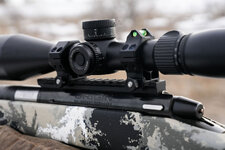TaperPin
WKR
- Joined
- Jul 12, 2023
- Messages
- 6,070
I seem to recall a number of videos - once you how quick and simple it is, it becomes a no brainer. Simply smear a little abrasive on the properly sized round metal bar, rub it back and forth a few times, wipe the abrasive off the rings and look at the contact. The ring caps are done on the gun, or separately off the gun in the same way. Most folks agree it’s best to simply take off the highest spots and leave most of the ring finish intact. It’s only the high spots that dig into a scope. The video below shows taking off a huge amount of material — more than I’d ever do.Any good videos out there on the lapping process?
As with any DIY project involving altering precision machined surfaces, the success is proportional to a person’s good judgement - as with any gunsmithing, practice on something you don’t care about before trying it on your favorite rifle.
It’s better to buy a lapping bar and abrasive that’s made for the purpose. However, the lapping bar can be anything that is really straight and slightly undersized to allow room for the thickness of the abrasive. Most cold rolled steel round stock from a metal supplier is slightly under size and plenty straight. Aluminum tube is dirt cheap although you’d need to check it for diameter and straightness.
Abrasive somewhere between 220 and 600 grit is commonly used. You can rub two pieces of 220 grit aluminum oxide sandpaper together over a paper plate and a lot will fall off - mix with a little oil and that works in a pinch. Valve grinding compound from Autozone is way more coarse than would be ideal, unless your lapping bar was well under size.

